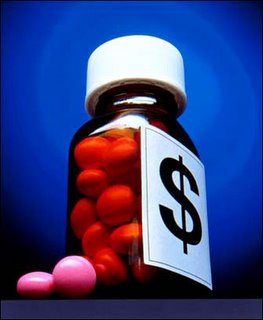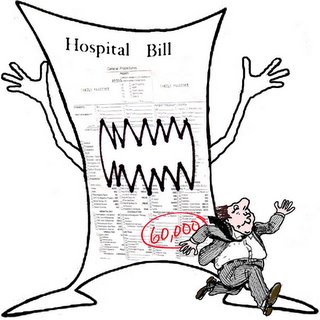
We’ve all seen the old cartoon. It’s so familiar, and has appeared in so many forms, it’s become a cliché. A man is passed out on the ground beside his mailbox. One arm is in a cast, evidently broken. The cause of his fainting spell? Not his injured arm, it seems: for clutched in the poor blighter’s good hand is a slip of paper he’s just removed from an envelope. It reads, “Doctor’s Bill.”
I’ve just received one of those. It’s from the good folks at Dr. Lerner’s office, covering about a month’s worth of medical services. The bottom line? $25,877.05.
That’s the bad news. The good news is the figure beside it. It says, “Insurance pending: $25,703.15. My balance due – for the moment (the difference between those two figures) – is $173.90. I get out the old checkbook, and mail off the payment.
What’s going to happen next is that my medical insurer, Highmark Blue Cross/Blue Shield (acting as agent for the Presbyterian Church’s Board of Pensions), will contact Dr. Lerner’s staff and tell them how much of that “insurance pending” figure they’re willing to pay. I’ll receive a new bill – for considerably less than $26,000, no doubt – of which my insurance will pay 80%. They may even pay more than 80%, if my 20% share takes me over the top of the annual stop-loss figure – that threshold after which my medical insurance swoops in and starts paying for everything. Given my bloated medical bills, I may well hit the stop-loss this month, just one-sixth of the way through the year. (In most prior years, our family has never reached that maximum.)
So where does that huge bottom line come from? A glance at the itemized bill makes it all too clear. A single dose of Rituxan (the new monoclonal antibody-therapy drug I receive along with my chemotherapy) costs $7,500. A single injection of Neulasta (the agent that stimulates white blood cell production) costs $3,000. A single treatment with the chemo drug adriamycin costs $780. Multiply those amounts by two (for the two rounds of chemo covered by this billing cycle), throw in some smaller amounts for the other chemo drugs, the nurses’ professional services and the IV paraphernalia, and it’s easy to see how easily you can shell out enough simoleons on a couple rounds of chemo to purchase a new car.
That is, if $25,877.05 is what the treatment really costs – because the real cost is anybody’s guess. Very few patients pay the full sticker price for their medical treatment. The price is overly inflated to begin with, because the medical providers know the insurance companies are going to come in like swaggering, muscle-bound thugs and negotiate the price down to what they’re willing to pay.
So who does pay full price? Not the fortunate patients like me who have medical insurance. Not the retirees on Medicare, and not the poorest of the poor on Medicaid either – for those huge Federal agencies can throw their weight around like the gorillas they are, and win some of the biggest price concessions in the business . The only people who do pay full price are the working poor who have no insurance: the people unlucky enough to work for Wal-Mart rather than GM.
 I’ve known more than a few of those unfortunate souls in the course of my ministry. What typically happens is that they have to “spend down” what meager assets they have – “spending down” is a euphemism for losing everything – until they qualify for Medicaid. The irony is that, in paying that overly inflated, full-price figure, they’re actually paying far more for the same medical services that the insured are getting at a much-reduced rate.
I’ve known more than a few of those unfortunate souls in the course of my ministry. What typically happens is that they have to “spend down” what meager assets they have – “spending down” is a euphemism for losing everything – until they qualify for Medicaid. The irony is that, in paying that overly inflated, full-price figure, they’re actually paying far more for the same medical services that the insured are getting at a much-reduced rate.Any sane, logical health-care financing system would require the wealthy to pay the most and the poor to pay the least. With the exception of the very poor who qualify for Medicaid, however, what our system does is to ask the wealthy to pay the least and the working poor to empty their pockets until they have nothing left. Meanwhile, a huge percentage of the money collected – some say as much as 40% – goes to maintain the armies of clerks, accountants and lawyers required to keep this cumbersome and unequal system from completely falling apart. It’s like putting to sea in a rusty old tramp steamer – does it really make more sense to pay ever-increasing numbers of sailors to huff and puff at the bilge pumps, when what you really need is to put the sorry old tub into drydock and rebuild it from the keel up?
 There are a few other places the needy can turn. Some drug companies have limited programs to offer discounted medicines to those who couldn’t otherwise afford them. Some doctors still have enough of an ethical sense to treat a limited number of needy patients pro bono. Some patients have circles of friends with the creativity and gumption to hold bake sales or firehouse dances to raise two or three thousand to throw into the kitty. Yet how many bake sales does it take to cover $100,000 or more for cancer treatment?
There are a few other places the needy can turn. Some drug companies have limited programs to offer discounted medicines to those who couldn’t otherwise afford them. Some doctors still have enough of an ethical sense to treat a limited number of needy patients pro bono. Some patients have circles of friends with the creativity and gumption to hold bake sales or firehouse dances to raise two or three thousand to throw into the kitty. Yet how many bake sales does it take to cover $100,000 or more for cancer treatment?This isn’t plastic surgery or liposuction. Nor is it some doubtful experimental tonic, hawked by shady characters south of the border to those who will pay anything for a little hope. This is the standard, frontline treatment – that which modern medicine considers necessary simply to stay alive.
I’m grateful to receive it – and I’m equally grateful for the medical insurance that means my kids will still be able to go to college and Claire and I can cherish some hope of being able to afford even a modest home in our retirement. But that sticker shock when you open the window envelope – it’s a health hazard in itself!
2 comments:
AMEN to that! One of the worst things about this country. And in my banruptcy practice I see the results of the uninsured literally every day.
Carl, this is a great evocative way to pursue the topic in tonight's class on Marcus Borg, "The Heart of Christianity", chapter 7. We are looking for systemic injustices that we can see around us. This is just perfect! So - you're now part of our curriculum! (3 in the group are not online, so have not seen it.) Robin
Post a Comment